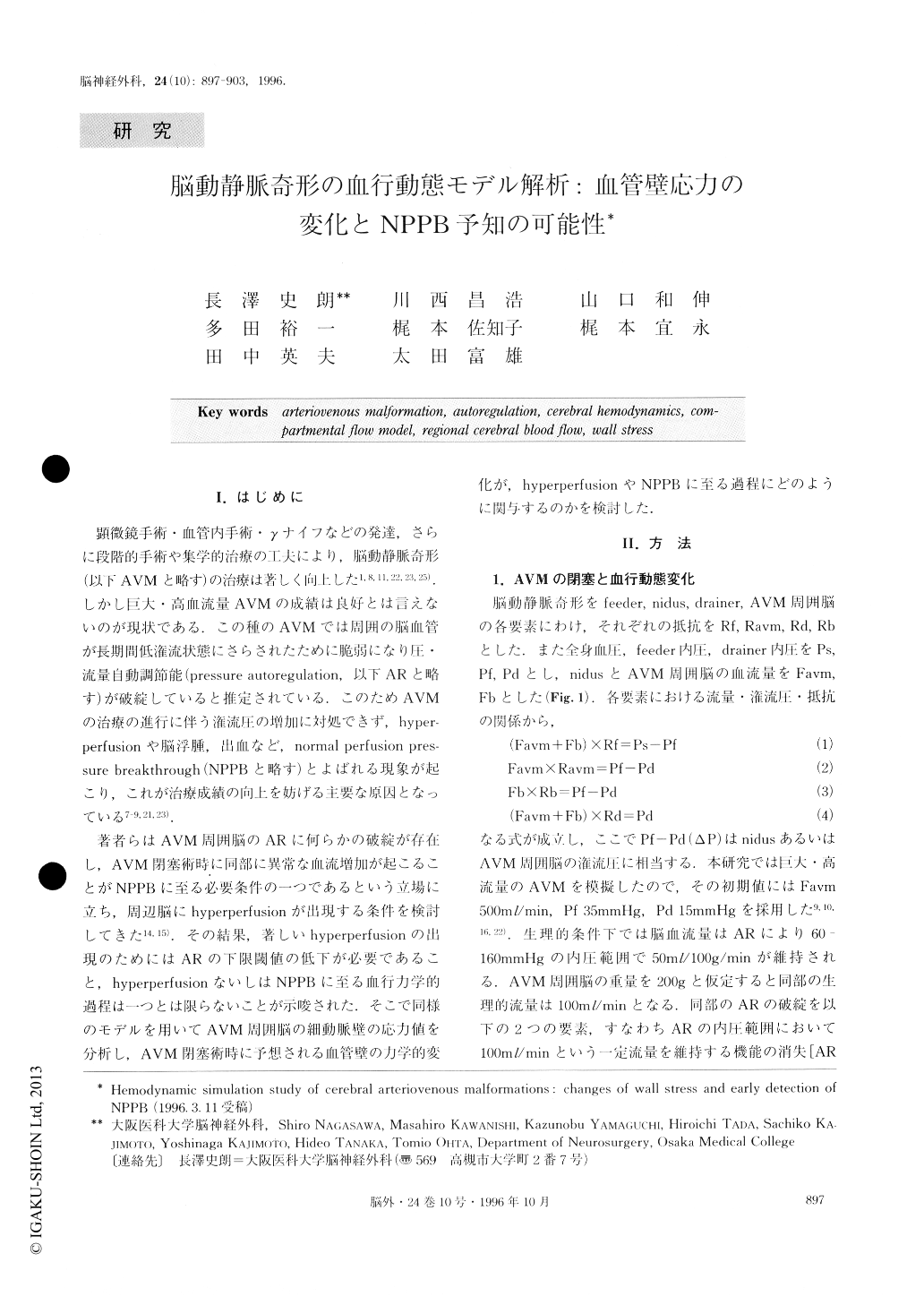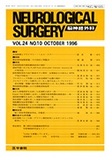Japanese
English
- 有料閲覧
- Abstract 文献概要
- 1ページ目 Look Inside
I.はじめに
顕微鏡手術・血管内手術・γナイフなどの発達,さらに段階的手術や集学的治療の工夫により,脳動静脈奇形(以下AVMと略す)の治療は著しく向上した1,8,11,22,23,25).しかし巨大・高血流量AVMの成績は良好とは言えないのが現状である.この種のAVMでは周囲の脳血管が長期間低潅流状態にさらされたために脆弱になり圧・流量自動調節能(pressure autoregulation,以下ARと略す)が破綻していると推定されている.このためAVMの治療の進行に伴う潅流圧の増加に対処できず,hyper—perfusionや脳浮腫,出血など,normal perfusion pres—sure breakthrough(NPPBと略す)とよばれる現象が起こり,これが治療成績の向上を妨げる主要な原因となっている7-9,21,23).
著者らはAVM周囲脳のARに何らかの破綻が存在し,AVM閉塞術時に同部に異常な血流増加が起こることがNPPBに至る必要条件の一つであるという立場に立ち,周辺脳にhyperperfusionが出現する条件を検討してきた14,15).その結果,著しいhyperperfusionの出現のためにはARの下限閾値の低下が必要であること,hyperperfusionないしはNPPBに至る血行力学的過程は一つとは限らないことが示唆された.そこで同様のモデルを用いてAVM周囲脳の細動脈壁の応力値を分析し,AVM閉塞術時に予想される血管壁の力学的変化が,hyperperfusionやNPPBに至る過程にどのように関与するのかを検討した.
Obliteration procedures for large high-flow arteriove-nous malformations (AVM) were simulated using a compartmental flow model to investigate the role of altered autoregulatory conditions in the development of hyperperfusion and normal perfusion pressure break-through (NPPB). Since the arterioles are primarily re-sponsible for autoregulatory function, the role of these structural changes on the development of hyperperfu-sion was also studied by evaluating the wall thickness (T), internal radius (Ri) and tangential wall stress (σ).
As the AVM flow was decreased during the oblitera-tion procedures, the perfusion pressure (△ P) of the brain tissue surrounding the AVM increased. When the autoregulatory condition was impaired [AR (-)] and the lower limit of the autoregulatory pressure range (LAR) was shifted from 60mmHg (LAR60) to 40 mm Hg (LAR40), the flow volume in the surrounding brain (Fb) increased markedly, from 67 ml/100g/min to 92ml/100g/min, with the progress of the obliteration procedures. In these conditions, T/Ri was supposed to be constant and σ value increased uniformly. In the presence of the autoregulatory mechanism [AR (+)],T/Ri increased against increasing △ P, which resulted in smaller σ value than that under AR (-) conditions. When the contracted vascular wall yielded on the pro-cess of increasing wall stress, △ P and feeder pressure (Pf) decreased to some degree. Concomitantly increase of the σ value and marked hyperperfusion developed in the brain. The yield of the contracted vascular wall would result in the decrease of a pressure gradient across the arteriole and the reciprocal increase of pres-sure load on the walls of the capillary and venula, which might lead to NPPB. Since the decrease of △ P or Pf during the progress of the obliterating procedures is considered specific to the appearance of hyperperfu-sion or NPPB, monitoring these parameters would be useful for its early detection.
If the upper limit of the autoregulatory pressure range was assumed to decrease and become the yield point in the brain surrounding high flow AVMs, hyper-perfusion or NPPB could be considered to develop in the conditions with the autoregulatory pressure range being narrowed and/or shifted to the lower pressure level.
Induced systemic hypotension was found to he effec-tive in reducing the magnitude of Fb, △ P, and Pf when induction was appropriately performed in stepwise fashion. T/Ri and σ were kept in narrow ranges com-pared to those before induction of hypotension.

Copyright © 1996, Igaku-Shoin Ltd. All rights reserved.


